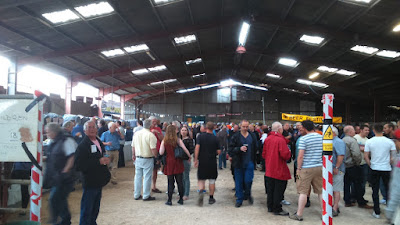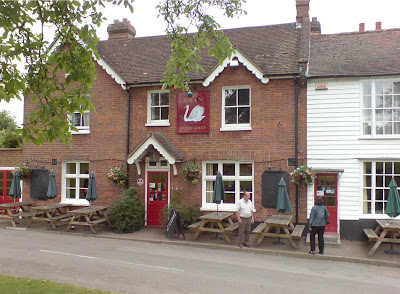As some of you will know, my wife has been rather poorly
since the start of the New Year, after suffering a nasty chest infection which developed into full-blown pneumonia. She ended up in intensive care in Maidstone hospital, and spent eight days on a ventilator under sedation, with various lines and drips attached to her.
She is now fortunately, conscious and was sitting up in a chair when we visited
her earlier this evening. She is still weak and confused in equal measures, so despite protestations to the contrary, she will need to remain in hospital for some time. So what with daily visits plus
all the cooking, washing and other household chores keeping me occupied, I
haven’t had a lot of time for writing of late.
I was therefore pleasantly surprised to come across an
article which I'd written over 10 years ago, or possibly even longer,
and whilst parts of it may seem a little dated, due to the many changes which
have occurred within the brewing industry, it is still worth a read, even if it’s
just for the historical value. The post is about Old Ales and Barley Wines and
my early experiences of these beers.
I always think that Old Ales and Barley Wines represent something to look forward to as winter approaches. Although their appearance usually heralds the start of colder weather, they help to brighten up what can otherwise be a depressing time of the year.
The majority of brewers produce either a draught Old Ale or Barley Wine these days; some even produce both. This is in addition to other dark beers such as Porters and Stouts. Sitting in a quiet country pub, in front of a roaring log fire, sipping a glass or two of Young’s Winter Warmer, Wadworth's Old Timer or Harvey’s Christmas Ale, is one of the finer pleasures in life. The rich, warming and potent nature of these beers not only helps to keep out the cold, but also helps satisfy the inner man.
 My first introduction to such brews came in the form of Young’s Winter Warmer - a very aptly named beer if ever there was one. Unfortunately, I remember neither the time nor the place, but believe that it must have been somewhere in Wandsworth, where Young’s pubs are thick on the ground.
My first introduction to such brews came in the form of Young’s Winter Warmer - a very aptly named beer if ever there was one. Unfortunately, I remember neither the time nor the place, but believe that it must have been somewhere in Wandsworth, where Young’s pubs are thick on the ground.My second introduction to winter ales came during my student days, back in the mid 1970’s, and was in the form of Robinson’s Old Tom. The latter is a rich, dark, warming and rather potent barley wine, with an alcohol content of 8.5%. The location where I first sampled this beer was the Star Inn, a tiny Robinson’s outlet, tucked away down a side road called Back Hope Street, in a backwater area of Salford. This particular pub was a favourite haunt of students and was also my local for a time, even though it involved a walk of some twenty minutes or so from where I was living at the time.
One evening, whilst enjoying a few pints in the Star, a friend and I were informed by the landlady that, with winter fast approaching, the pub would be getting some Old Tom Ale in for customers to try. The prospect of sampling what we had hitherto regarded as a bottled beer only was an exciting one, but after a couple of fruitless visits, when we were told that the beer had either not arrived, or that it had arrived but wasn't quite ready to serve, we finally struck lucky. Perched up on the bar, was a small wooden cask, full of Old Tom.

We awaited our first taste with eager anticipation, as the landlady slowly filled our glasses, but to our surprise she insisted on serving us in half pint glasses. It appeared that pints were considered too much for this rather potent beer! The beer was black, sweet, extremely potent and nice and warming. My friend and I made several more visits to the Star for a glass or two of Old Tom before that particular cask ran out.
 After that supplies seemed to become somewhat erratic, and on a subsequent occasion we were only alerted to the beer's availability by the bizarre behaviour of one of the students who shared a house with us. "Mild-mannered" Martin, a shy and somewhat retiring type, had to be physically restrained one night after running amok wielding a machete!
After that supplies seemed to become somewhat erratic, and on a subsequent occasion we were only alerted to the beer's availability by the bizarre behaviour of one of the students who shared a house with us. "Mild-mannered" Martin, a shy and somewhat retiring type, had to be physically restrained one night after running amok wielding a machete!We later found out that he had spent the evening in the Star, and had managed to consume three pints of Old Tom! As he was someone who didn't normally drink, one can only describe him as being off his trolley. Certainly he had no recollection of his strange behaviour the following day, although he was suffering from a king-size hangover!
It must have been around this time that I first sampled Theakston's Old Peculier. I had tried the bottled version a year or two previously, but found the cask-conditioned version to be far superior. The place where I enjoyed this legendary drink was the Ram's Head, a wonderfully unspoilt and remote pub high up on the moors above Oldham. The Ram's Head, or "Owd Tupps" as it was commonly known as, is the subject of a previous post, so I won't elaborate any further here.
 Later on, whilst still living in the Greater Manchester area, my friend and I were able to track down other barley wines and winter ales. Prominent amongst these were Boddington’s Strong Ale, now sadly discontinued and Hyde’s Anvil Strong Ale. When I moved to London, following the completion of my studies, I discovered that a number of Charrington’s pubs sold Highgate Old Ale, from the West Midlands based company of the same name, during the winter months.
Later on, whilst still living in the Greater Manchester area, my friend and I were able to track down other barley wines and winter ales. Prominent amongst these were Boddington’s Strong Ale, now sadly discontinued and Hyde’s Anvil Strong Ale. When I moved to London, following the completion of my studies, I discovered that a number of Charrington’s pubs sold Highgate Old Ale, from the West Midlands based company of the same name, during the winter months.Upon returning to Kent I renewed what had been a fleeting acquaintance with Shepherd Neame Stock Ale. I later discovered there was nothing particularly special about Stock Ale as it was just the company's Best Bitter with added caramel, which explains why I found it rather on the thin side. Much more full bodied and enjoyable were Harvey’s Old and King and Barnes Old. These two Sussex brewers seem to have cracked the art of producing a fine, mellow old ale, that is just the right balance between being smooth and warming, without being too strong in alcohol. Wethered’s Winter Royal was another fine winter beer that made a fleeting appearance in Kentish pubs during this time, as were the various incarnations of Greene King's Winter Ale.
 I mentioned Shepherd Neame Stock earlier. Whilst this may have been on the weak side, the same could not be said of the company's Christmas Ale. This was a very strong, bottled pale ale, brewed specially for the festive season. Sadly it was discontinued some years ago, although I do have sitting on my shelf a couple of bottles of Shepherd Neame 1996 Vintage Christmas Ale 6.7% ABV. This is a limited edition bottled beer, packaged in an attractive box. According to the label, "This year's ale contains cinnamon spice and the best 1995 malted barley and Kentish hops".
I mentioned Shepherd Neame Stock earlier. Whilst this may have been on the weak side, the same could not be said of the company's Christmas Ale. This was a very strong, bottled pale ale, brewed specially for the festive season. Sadly it was discontinued some years ago, although I do have sitting on my shelf a couple of bottles of Shepherd Neame 1996 Vintage Christmas Ale 6.7% ABV. This is a limited edition bottled beer, packaged in an attractive box. According to the label, "This year's ale contains cinnamon spice and the best 1995 malted barley and Kentish hops". Courage Russian Imperial Stout is another bottled conditioned beer which is well worth mentioning. This legendary beer, only available in third of a pint nips, was originally brewed for trade with the Baltic, and was reputedly a favourite of the Russian Empress, Catherine the Great. It wasn’t originally a Courage beer, but instead was brewed by their south London neighbours, Barclay Perkins. With a reputed strength approaching 11% ABV. it was certainly a beer to be treated with respect, yet one night I remember a friend drinking twelve bottles (equivalent to four pints!) and still managing to walk home unaided. Sadly, Russian Imperial Stout was discontinued early in 1998. The excuse given by the brewery was “lack of demand”. (Lack of promotion, and poor availability would probably be nearer the truth!)
Courage Russian Imperial Stout is another bottled conditioned beer which is well worth mentioning. This legendary beer, only available in third of a pint nips, was originally brewed for trade with the Baltic, and was reputedly a favourite of the Russian Empress, Catherine the Great. It wasn’t originally a Courage beer, but instead was brewed by their south London neighbours, Barclay Perkins. With a reputed strength approaching 11% ABV. it was certainly a beer to be treated with respect, yet one night I remember a friend drinking twelve bottles (equivalent to four pints!) and still managing to walk home unaided. Sadly, Russian Imperial Stout was discontinued early in 1998. The excuse given by the brewery was “lack of demand”. (Lack of promotion, and poor availability would probably be nearer the truth!)Whitbread Gold Label Barley Wine, originally brewed by Tennant Bros. of Sheffield, ended up supplanting many other barley wines. It even saw off Whitbread's own barley wine - Final Selection. Somewhat unusually, it is a pale beer, unlike the more usual dark colour of most barley wines. Bass No 1 Barley Wine also bit the dust some years back, although it has now been resurrected, in cask-conditioned form, by the small-scale brewery at the Bass Museum in Burton-on Trent. It is brewed during the summer and aged for six months in oak casks. Supplies though, are strictly limited and it is normally necessary to visit the museum itself in order to sample it.





















